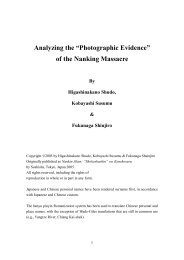The Senkaku Islands Constitute an Intrinsic Part of Japan
The Senkaku Islands Constitute an Intrinsic Part of Japan
The Senkaku Islands Constitute an Intrinsic Part of Japan
Create successful ePaper yourself
Turn your PDF publications into a flip-book with our unique Google optimized e-Paper software.
THE COMPETING CLAIMS<br />
<strong>The</strong> claims <strong>of</strong> China <strong>an</strong>d Taiw<strong>an</strong> have a similar basis. China asserts that fishermen<br />
from Taiw<strong>an</strong> used the isl<strong>an</strong>ds for fishing activities since the time <strong>of</strong> the Ming Dynasty<br />
(1368-1644). Journeys by Chinese envoys to Okinawa during this period are cited, for<br />
these envoys sometimes recorded that the western boundary <strong>of</strong> the Ryukyu isl<strong>an</strong>ds<br />
(Okinawa is the largest isl<strong>an</strong>d <strong>of</strong> the Ryukyus) lay at a point east <strong>of</strong> the <strong>Senkaku</strong>s<br />
(Diaoyus). In 1893, the Dowager Empress <strong>of</strong> China, Tze Shih, made a gr<strong>an</strong>t <strong>of</strong> the<br />
isl<strong>an</strong>ds to one Sheng Hsu<strong>an</strong> Wai, who collected medical herbs on them.1 However, China<br />
never established a perm<strong>an</strong>ent settlement <strong>of</strong> civili<strong>an</strong>s or military personnel on the isl<strong>an</strong>ds,<br />
<strong>an</strong>d apparently did not maintain perm<strong>an</strong>ent naval forces in adjacent waters.2<br />
Jap<strong>an</strong> did not claim the isl<strong>an</strong>ds until the Sino-Jap<strong>an</strong>ese War <strong>of</strong> 1894-1895. On<br />
J<strong>an</strong>uary 14, 1895, the Emperor approved <strong>an</strong> Imperial Ordin<strong>an</strong>ce <strong>an</strong>nexing the <strong>Senkaku</strong>s<br />
to Jap<strong>an</strong>.3 In May 1895, Jap<strong>an</strong> <strong>an</strong>d China signed the Treaty <strong>of</strong> Shimonoseki ending the<br />
war. Under the Treaty, China ceded Taiw<strong>an</strong> (Formosa) to Jap<strong>an</strong> "together with all the<br />
isl<strong>an</strong>ds appertaining or belonging to the said isl<strong>an</strong>d <strong>of</strong> Formosa." <strong>The</strong> Treaty did not<br />
mention the <strong>Senkaku</strong>s, <strong>an</strong>d the isl<strong>an</strong>ds were not discussed during the negotiating<br />
sessions.4 Jap<strong>an</strong> has claimed from this that its incorporation <strong>of</strong> the <strong>Senkaku</strong>s (Diaoyus)<br />
was <strong>an</strong> act apart from the Sino-Jap<strong>an</strong>ese War. China argues that Jap<strong>an</strong> used its victory<br />
in the war to <strong>an</strong>nex the isl<strong>an</strong>ds. China also argues that the intent <strong>of</strong> the allied<br />
declarations at Cairo <strong>an</strong>d Potsdam during World War II was to restore to China<br />
territories taken from it by Jap<strong>an</strong> through military aggression.5<br />
U.S. ADMINISTRATION OF THE ISLANDS, 1953-1971<br />
U.S. administration <strong>of</strong> the isl<strong>an</strong>ds beg<strong>an</strong> in 1953 as a result <strong>of</strong> the 1951 Treaty <strong>of</strong><br />
Peace with Jap<strong>an</strong>. <strong>The</strong> Treaty did not mention the <strong>Senkaku</strong>s (Diaoyus), but it referred to<br />
other isl<strong>an</strong>ds that had reverted to Chinese control or which China claimed. <strong>The</strong>se<br />
included Taiw<strong>an</strong>, the Pescadores, the Spratlys, <strong>an</strong>d the Paracels. Article 3 gave the<br />
United States sole powers <strong>of</strong> administration <strong>of</strong> "N<strong>an</strong>sei Shoto south <strong>of</strong> 29 north latitude.”<br />
In 1953, the U.S. Civil Administration <strong>of</strong> the Ryukyus issued U.S. Civil Administration <strong>of</strong><br />
the Ryukyus Proclamation 27 (USCAR 27), which defined the boundaries <strong>of</strong> "N<strong>an</strong>sei<br />
Shoto south <strong>of</strong> 29 degrees north latitude" to include the <strong>Senkaku</strong>s.6 At the time <strong>of</strong> the<br />
signing <strong>of</strong> the Okinawa Reversion Treaty, several State Department <strong>of</strong>ficials asserted that<br />
following the signing <strong>of</strong> the Jap<strong>an</strong> Peace Treaty, "N<strong>an</strong>sei Shoto south <strong>of</strong> 29 degrees north<br />
latitude" was "understood by the United States <strong>an</strong>d Jap<strong>an</strong> to include the <strong>Senkaku</strong><br />
<strong>Isl<strong>an</strong>ds</strong>."7 Moreover, during the period <strong>of</strong> U.S. administration, the U.S. Navy established<br />
firing r<strong>an</strong>ges on the isl<strong>an</strong>ds <strong>an</strong>d paid <strong>an</strong> <strong>an</strong>nual rent <strong>of</strong> $11,000 to Jinji Koga, the son <strong>of</strong><br />
the first Jap<strong>an</strong>ese settler <strong>of</strong> the isl<strong>an</strong>ds. (End <strong>of</strong> the abstract.)<br />
Excluding the description <strong>of</strong> China‟s sovereignty claim, the report is accurate. <strong>The</strong><br />
reference to China‟s claim that Taiw<strong>an</strong>ese fishermen fished the disputed waters during<br />
the Ming Dynasty is replete with error. For one thing, the Ming Dynasty never possessed<br />
Taiw<strong>an</strong>. Moreover, because Taiw<strong>an</strong>ese‟s fishing methods at the time were primitive,<br />
they would never have fished in waters near the <strong>Senkaku</strong>s a dist<strong>an</strong>ce that even Okinaw<strong>an</strong><br />
26












